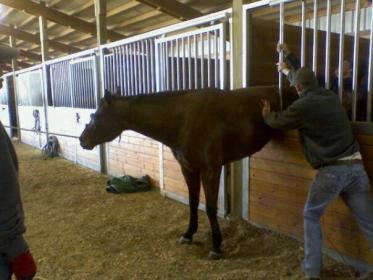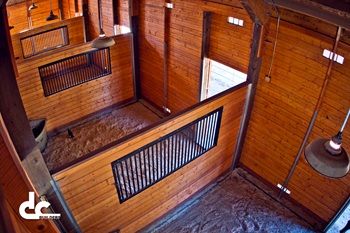You might be happier with sliding doors, especially if aisle is narrow. I am not sure WHY folks love heads hanging out in the aisle, but have only seen problems from allowing it. You have to repair lower doors constantly with horse pushing it off the wall screws. Swing of door takes up a lot of space, hangs up when door is not hung right again after repairs. You could put up a full mesh door, slider, to give you plenty of air flow. We used beveled blocks at the base of doors to hold the bottoms down, with a stopper block on the wall for open slider door. No rods or sharp metal edges devices that horse could step on and hurt themselves. Wood blocks still in place with many injury free years of horses going down the aisles. Doors do NOT move outward if kicked or rubbed on. I love sliders, they are NEVER in my way when using the aisle, have never needed any repairs over those many years of use.
I don’t have horses knocking gates loose, removing things hung by the stall, leaning out to bite passing horses, jumping out of their stall when buddy leaves. We drive tractor and spreader thru the barn, hay trailers to unload, no heads out to get hurt on as machinery goes by. Sure saves on repair of things in the barn!
I would suggest you put buckets in the front of stall. Horses tend to stand there watching stuff, so they drink better with buckets right under their noses. Having hay in front by the window also keeps the poop towards the rear, with horse standing and eating there. Not pooping on good hay in the back, as horse circles to get a bit, then look out front again.
I know you want to save money, but perhaps a local shop could buy the heavy mesh, make up your stall screens and sliding doors for you. The mesh could be the stuff used for caging off industrial areas, with 2"x2" openings that will prevent horse getting caught on. There are quite a few manufacturers of mesh stall products that can make panels or doors up to your specs, once you give them measurements.
See if there is a local person or sawmill to buy rough cut lumber for your stalls. It is cheaper, larger dimensions because it has not been planed smooth. Horses “usually” don’t chew on it as much as nice pine from the lumber yard! We used Oak for inside walls, white Oak is harder than Red oak, if I remember correctly. Or some other hard wood available locally. Elm is great if you can find it. Use galvanized nails if wood is green, the tannic acid in Oak will rust plain nail heads off in a couple years. Oak hardens as it hangs in the stall, so you don’t want to be putting in nails with hardened oak!! You would probably have to drill those holes, not just hammer them in!
You might want to provide chewing logs in the field or paddocks, giving them something to gnaw on that is OK to eat. Willow, dry Oak, hickory woods are making my horses happy with the winter need to chew they all get. The Mule is different, they chew all the time. Mule folks I know have pipe corrals, mules ate the wood to nubbins. I would make sure he had a good log to chew year around!
We had the local furnace place bend galvanized sheet metal to cover all wood edges in the stalls. Make sure you get those sharp edges bent down, then nailed down, to prevent accidental slicing. Sure saved any gnawing on stall edges! They could make long runs in the shop, we installed it ourselves and it was pretty inexpensive, fit exactly tight on the places we needed it.
Hope these ideas can help you save a few dollars.





